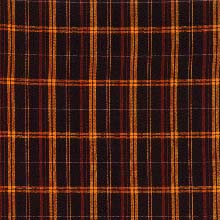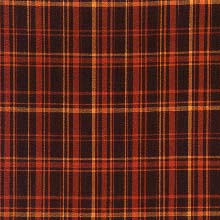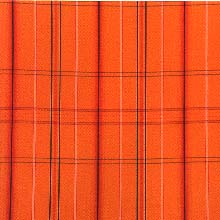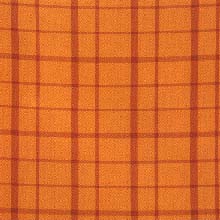Weave (p. 76 )
1.Produced in Hachijomachi Hachijojima, Tokyo.
2. Characteristics: Silk fabric dyed with plant dyes and with vertical and cross stripes, totally hand woven with threads dyed in 3 different colors: yellow, brown and black. Various kinds of stripes in various combinations of threads with various shades of colors. The fabric is light, tough and lustrous. The name "Kihachijo" means yellow fabric produced in the Hachijo Island but the name also covers those in other colors.
3. Uses: Clothing, "Hanten"(short coats), "Tanzen"(quilted kimonos), sashes, neckties, etc.
4. History: White plain silk was woven in the Heian Period and was used as a tribiue to the government as "Ki Tsumugi"(yellow pongee) in the Muromachi Period and as "Ki Tsumugi" or "Hachijo Jima"(Hachijo Stripes) in the Edo Period . They were worn only by people in higher class such as feudal lords till the 1800-1830. The name "Kihachijo" appeared in the late Edo and early Meiji Periods when it was most popular.
Dyeing Method
"Hachijo Kariyasu"(Miscanthus tinctorius) is used to dye "Ki Hachijo", the bark of "Madami"(Tabunoki, Machilus thunbergii) for "Tobi Hachijo"(Brown Hachijo) and the bark of "Shiinoki"(Castanopsis cuspidata) for "Kuro Hachijo"(black Hachijo).
1. "Ki Zome"(yellow dyeing) for "Kihachijo"
a. Decoction comes from the water in which dried plants("Kariyasu") are boiled 4 or 5 hours.
b. Threads are dipped for a night in the hot decoction.
c. Threads are squeezed and dried in the sun next morning.
d. The above process is repeated about 15 times and the color is fixed in the mordant of ashes of "Tsubaki"(Camellia japonica) and "Sakaki"(Cleyera japonica).
2. "Kaba Zome"(Brown dyeing) for "Tobi Hachijo"
a. Finely cut bark of "Madami" are boiled for 6 to 7 hours to produce a decoction. Barks are taken out of the decoction and dried and burned to ashes.
b. Ashes are put into decoction to bubble and grow red.
c. The decoction is poured onto the threads and left for a night.
d. Next morning, threads are squeezed and dried in the sun.
e. The process above is repeated about 15 times and then the threads are put in the lye.The ashes in "Irori"(hearth) are used as the lye after they are solved in the water at a definite ash-water rate.
f. The process above is repeated several times.
3. "Kuro Zome"(Black dyeing) for "Kuro Hachijo"
a. Decoction is made after the dried bark of "Shiinoki" is boiled for 6 or 7 hours.
b. As in the "Ki Zome," thread dripping in the decoction is repeated about 15 times. Then the threads are dipped in muddy water in a marsh which contains iron. This is an iron mordant called "Numa Zuke"(marsh dipping).
c. After the threads are well soaked in the muddy water, the threads are washed in water and dried in the sun.
d. The above process of decoction dipping(5 or 6 times): marsh dipping; decoction dipping(1 or 2 times); again marsh dipping; is repeated in order to give color to the threads.






